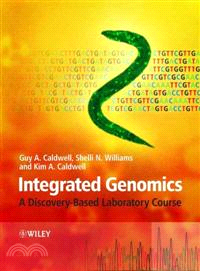Integrated Genomics - A Discovery-Based Laboratory Course
商品資訊
定價
:NT$ 12353 元優惠價
:90 折 11118 元
若需訂購本書,請電洽客服 02-25006600[分機130、131]。
相關商品
商品簡介
作者簡介
目次
商品簡介
Integrated Genomics: A Discovery-Based Laboratory Course introduces the excitement of discovery to the basic molecular biology laboratory. Utilizing up-to-date molecular biology protocols and a basic experimental design, this text offers experience with three different model systems. Students will become familiar with the simplicity and power of single-celled organisms, Escherichia coli and Saccharomyces cerevisiae, as they search for genes that interact and function within the nematode Caenorhabditis elegans.
Incorporated throughout the course are exercises designed to offer students familiarity with the wealth of bioinformatics data that can be accessed on the World Wide Web. Following completion of interaction studies within the yeast, the course is designed to allow students to examine the functional consequences of reducing a gene’s function within the multicellular worm that is both simple and inexpensive to maintain within a laboratory. The inclusion of alternative experiments allow for flexibility in determining the ending date or goal of the laboratory, as well as working within the available budget and resources of most any classroom environment.
Further striking features of this title are:
An accompanying Web site providing PowerPoint slides, plus links to the internet, and regular updates as bioinformatics databases evolve and methods improve. www.wiley.com/go/caldwell
Inclusion of modern genomic/proteomic technologies such as the yeast two-hybrid system and RNAi
Detailed experimental protocols and easy access to instructional materials
This discovery-based laboratory course provides excellent practical training for those pursuing career paths in biomedicine, pharmacy, and biotechnology.
Incorporated throughout the course are exercises designed to offer students familiarity with the wealth of bioinformatics data that can be accessed on the World Wide Web. Following completion of interaction studies within the yeast, the course is designed to allow students to examine the functional consequences of reducing a gene’s function within the multicellular worm that is both simple and inexpensive to maintain within a laboratory. The inclusion of alternative experiments allow for flexibility in determining the ending date or goal of the laboratory, as well as working within the available budget and resources of most any classroom environment.
Further striking features of this title are:
An accompanying Web site providing PowerPoint slides, plus links to the internet, and regular updates as bioinformatics databases evolve and methods improve. www.wiley.com/go/caldwell
Inclusion of modern genomic/proteomic technologies such as the yeast two-hybrid system and RNAi
Detailed experimental protocols and easy access to instructional materials
This discovery-based laboratory course provides excellent practical training for those pursuing career paths in biomedicine, pharmacy, and biotechnology.
作者簡介
Guy A. Caldwell, PhD, is an Associate Professor in the Department of Biological Sciences at the University of Alabama, where since 1999 he has held an undergraduate professorial appointment from the Howard Hughes Medical Institute. He holds an adjunct appointment at the University of Alabama at Birmingham, as an Assistant research Professor of Neurology. In 2001, Dr Caldwell was named a Bail O' Connor Scholar of The March of Dimes Birth Defects Foundation for his research into the molecular basis of childhood birth defects of the brain. Dr Caldwell is a recipient of grants from The March of Dimes, National Institutes of Health, Dystonia Medical Research Foundation, Parkinson's Disease Foundation, National Parkinson Foundation, and the Bachmann-Strauss Dystonia & Parkinson Foundation. In 2003, The Caldwell Laboratory was selected as 1 0f 11 groups worldwide to represent the research goals of the Michael J. Fox Foundation for Parkinson's research in their Protein Degradation Grant Initiative. For his combines teaching and research efforts, Dr Caldwell was also chosen as the recipient of a 2003 CAREER Award from the National Science Foundation. In 2005, he was named Alabama Professor of the Year by the Carnegie Foundation for the Advancement of Teaching and Council for Advancement and Support of Education. Dr Caldwell, a native of the New York City area, received his undergraduate degree in Biology from Washington & Lee University in 1986 and his PhD in Cell, Molecular & Developmental Biology from The University of Tennessee in 1993. Following receipt of his doctorate, he moved to Columbia University in New York where he was twice named the recipient of fellowships from the National Institute of Neurological Disease and Stroke. He is the author of two editions of a widely adopted textbook, Biotechnology: A Laboratory Course, published worldwide in three languages. He teaches courses in Integrated Genomics, Neuronal Signaling, General biology, and an acclaimed seminar on the societal impact of the Human Genome Project.
Shelli N. Williams, PhD, is a research scientists at a private forensic company based in Virginia. Following her early graduation Magna cum laude from undergraduate studies, Dr Williams began her graduate work in the laboratory of Drs Guy and Kim Caldwell at The University of Alabama, where she earned her doctorate from The University of Alabama in 2006. Dr Williams served as an adjunct faculty member in New College, an interdisciplinary department at The University of Alabama, where she was the instructor of a seminar course demonstrating how the nature of the laboratory experience plays an essential role in the understanding and advancement of science. She has experience plays an an essential role in the understanding and advancement of science. She has experience teaching introductory biology courses to both majors and non-majors students and has been a repeated guest lecturer in a cross-disciplinary bioethics class. As a PhD candidate, Dr Williams served as a teaching assistant for Integrated genomics, a discovery-based genomics course funded by the Howard Hughes Medical Institute. Dr Williams was named the recipient of two university-wide Graduate Council Fellowships, as well as receiving recognition as an Isabella Hummel graham Scholar honoring outstanding female students throughout the university. She also received a competitive Worthington Biochemical Travel Award from the American Society of Cell Biology, Placing her among the highest honored student researchers at their 2003 Conference. Subsequent graduate work establishing Caenorhabditis elegans as a model for epilepsy was high-lighted in news releases by the Howard Hughes Medical Institute. In recognition of her accomplishments, Dr Williams was awarded the 2005 Joab Langston Thomas Award, the top honor for PhD students in Biological Sciences at the University of Alabama.
Kim A. Caldwell, PhD, is an Assistant Professor in the Department of Biological Sciences at The University of Alabama. Dr Caldwell is a Faculty Affiliate of The University of Alabama Center for Green Manufacturing and she is an Adjunct research Assistant Professor in the Department of Neurology at the University of Alabama at Birmingham Medical School. Dr Caldwell, a native of the Buffalo area, received her undergraduate degree in recombinant Gene Technology from the State University of New York at Fredonia and her MS and PhD degrees in Biotechnology and Cell, Molecular & Developmental Biology, respectively, from The University of Tennessee, While at Tennessee, Dr Caldwell was a four-time recipient of the Oak Ridge National Lab-UT Science Alliance teaching/research Award and the Chancellor's Award for Extraordinary Professional Promise. Following receipt of her doctorate, she held postdoctoral research appointments at the Rockefeller University and Columbia University in New York, during which time he was named the recipient of a Revson Fellowship and a National research Service Award from the National Institue of Child Health and Human Development. Her research has been published in many outstanding peer-reviewed journals, including Nature, Proceedings of the National Academy of Sciences, Journal of Neuroscience, Human Molecular Genetics the Journal of Cell Science and Development. Dr Caldwell serves as Director of the Howard Hughes Medical Institute rural Science Scholars program at Alabama. Additionally, she has designed and taught courses in General Biology, a seminar on the societal impact of the Human Genome Project, and a course entitled ' the Language of research', which she teaches jointly for Howard Hughes research Interns at both Stillman College and the University of Alabama. For her teaching efforts,in 2005 Dr Caldwell was selected as a Education Fellow in the Life Sciences of the National Academy of Sciences.
Shelli N. Williams, PhD, is a research scientists at a private forensic company based in Virginia. Following her early graduation Magna cum laude from undergraduate studies, Dr Williams began her graduate work in the laboratory of Drs Guy and Kim Caldwell at The University of Alabama, where she earned her doctorate from The University of Alabama in 2006. Dr Williams served as an adjunct faculty member in New College, an interdisciplinary department at The University of Alabama, where she was the instructor of a seminar course demonstrating how the nature of the laboratory experience plays an essential role in the understanding and advancement of science. She has experience plays an an essential role in the understanding and advancement of science. She has experience teaching introductory biology courses to both majors and non-majors students and has been a repeated guest lecturer in a cross-disciplinary bioethics class. As a PhD candidate, Dr Williams served as a teaching assistant for Integrated genomics, a discovery-based genomics course funded by the Howard Hughes Medical Institute. Dr Williams was named the recipient of two university-wide Graduate Council Fellowships, as well as receiving recognition as an Isabella Hummel graham Scholar honoring outstanding female students throughout the university. She also received a competitive Worthington Biochemical Travel Award from the American Society of Cell Biology, Placing her among the highest honored student researchers at their 2003 Conference. Subsequent graduate work establishing Caenorhabditis elegans as a model for epilepsy was high-lighted in news releases by the Howard Hughes Medical Institute. In recognition of her accomplishments, Dr Williams was awarded the 2005 Joab Langston Thomas Award, the top honor for PhD students in Biological Sciences at the University of Alabama.
Kim A. Caldwell, PhD, is an Assistant Professor in the Department of Biological Sciences at The University of Alabama. Dr Caldwell is a Faculty Affiliate of The University of Alabama Center for Green Manufacturing and she is an Adjunct research Assistant Professor in the Department of Neurology at the University of Alabama at Birmingham Medical School. Dr Caldwell, a native of the Buffalo area, received her undergraduate degree in recombinant Gene Technology from the State University of New York at Fredonia and her MS and PhD degrees in Biotechnology and Cell, Molecular & Developmental Biology, respectively, from The University of Tennessee, While at Tennessee, Dr Caldwell was a four-time recipient of the Oak Ridge National Lab-UT Science Alliance teaching/research Award and the Chancellor's Award for Extraordinary Professional Promise. Following receipt of her doctorate, she held postdoctoral research appointments at the Rockefeller University and Columbia University in New York, during which time he was named the recipient of a Revson Fellowship and a National research Service Award from the National Institue of Child Health and Human Development. Her research has been published in many outstanding peer-reviewed journals, including Nature, Proceedings of the National Academy of Sciences, Journal of Neuroscience, Human Molecular Genetics the Journal of Cell Science and Development. Dr Caldwell serves as Director of the Howard Hughes Medical Institute rural Science Scholars program at Alabama. Additionally, she has designed and taught courses in General Biology, a seminar on the societal impact of the Human Genome Project, and a course entitled ' the Language of research', which she teaches jointly for Howard Hughes research Interns at both Stillman College and the University of Alabama. For her teaching efforts,in 2005 Dr Caldwell was selected as a Education Fellow in the Life Sciences of the National Academy of Sciences.
目次
Preface.
Author biographies.
Acknowledgments.
List of figures.
1 Introduction to basic laboratory genetics.
1.1 Transferring and handling C. elegans.
1.2 Introduction to laboratory genetics.
2 Gene expression analysis using transgenic animals.
2.1 Transgenic gene expression analysis in C. elegans: lacZ staining.
2.2 Transgenic gene expression analysis in C. elegans: GFP analysis.
3 Creation and testing of transgenic yeast for use in protein–protein interaction screening.
3.1 Small-scale transformation of S. cerevisiae.
3.2 Transformation of S. cerevisiae to test for non-specific interaction.
3.3 Assaying for protein–protein interaction by reporter gene expression.
4 Yeast two-hybrid screening.
4.1 Protein–protein interaction screening of a C. elegans cDNA library.
4.2 Assaying for protein–protein interaction by reporter gene expression.
5 Isolation and identification of interacting proteins.
5.1 Preparation of electrocompetent E. coli.
5.2 Isolation of DNA from yeast and electroporation of E. coli.
5.3 Small-scale isolation of plasmid DNA from E. coli: the mini-prep.
5.4 Sequencing of two-hybrid library plasmid DNA vectors.
6 Using bioinformatics in modern science.
6.1 DNA sequence chromatogram.
6.2 BLASTing your sequence.
6.3 Evaluating sequence results and choosing an RNAi target.
6.4 Bioinformatics practice questions.
7 Generation of an RNAi vector.
7.1 Small-scale isolation of genomic DNA from C. elegans.
7.2 PCR amplification of target gene sequence from C. elegans genomic DNA.
7.3 Preparations for cloning to generate RNAi vector.
7.3.1 Agarose gel electrophoresis.
7.3.2 Removal of dNTPs from PCR reaction.
7.3.3 Restriction enzyme digestion of PCR product and C. elegans RNAi vector.
7.4 Gel purification of DNA and ligation of vector and PCR-amplified DNA.
7.4.1 Preparative agarose gel electrophoresis.
7.4.2 Gel purification of DNA from agarose gel.
7.4.3 Ligation of vector and PCR-amplified DNA.
7.5 Transformation of ligation reactions.
7.6 PCR screening of transformation colonies.
7.7 Small-scale isolation of plasmid DNA from E. coli: the mini-prep.
7.8 Verifying successful ligation by restriction digestion.
8 RNA-mediated interference by bacterial feeding.
8.1 Preparation of RNAi-feeding bacteria for transformation.
8.2 Media preparation for RNAi feeding.
8.3 Transformation of RNAi-feeding strain HT115(DE3).
8.4 RNA interference by bacterial feeding of C. elegans.
8.5 Analyzing effects of dsRNAi.
8.5.1 Assaying for sterility (Ste) or embryonic lethality (Emb).
8.5.2 Assaying for growth effect.
8.5.3 Assaying for morphological effects.
8.5.4 Assaying for general neuromuscular effects.
8.5.5 Assaying for specific neuronal effects.
8.5.6 Assaying for dauer formation.
Appendix I Recombinational cloning.
AI.1 Isolation of genomic DNA from C. elegans.
AI.2 PCR amplification of target gene sequence from C. elegans genomic DNA.
AI.3 Agarose gel electrophoresis and clean-up of PCR reaction.
AI.4 Entry vector cloning.
AI.5 Small-scale isolation of plasmid DNA from E. coli: the mini-prep.
AI.6 Destination vector cloning.
AI.7 Small-scale isolation of plasmid DNA from E. coli: the mini-prep.
Appendix II Recipes and media preparation.
Solution recipes.
Media preparation.
Appendix III Sterile techniques and worm protocols.
Sterile techniques.
Worm protocols.
Appendix IV Mutant C. elegans phenotypes.
Appendix V Vector maps.
Subject index.
Author biographies.
Acknowledgments.
List of figures.
1 Introduction to basic laboratory genetics.
1.1 Transferring and handling C. elegans.
1.2 Introduction to laboratory genetics.
2 Gene expression analysis using transgenic animals.
2.1 Transgenic gene expression analysis in C. elegans: lacZ staining.
2.2 Transgenic gene expression analysis in C. elegans: GFP analysis.
3 Creation and testing of transgenic yeast for use in protein–protein interaction screening.
3.1 Small-scale transformation of S. cerevisiae.
3.2 Transformation of S. cerevisiae to test for non-specific interaction.
3.3 Assaying for protein–protein interaction by reporter gene expression.
4 Yeast two-hybrid screening.
4.1 Protein–protein interaction screening of a C. elegans cDNA library.
4.2 Assaying for protein–protein interaction by reporter gene expression.
5 Isolation and identification of interacting proteins.
5.1 Preparation of electrocompetent E. coli.
5.2 Isolation of DNA from yeast and electroporation of E. coli.
5.3 Small-scale isolation of plasmid DNA from E. coli: the mini-prep.
5.4 Sequencing of two-hybrid library plasmid DNA vectors.
6 Using bioinformatics in modern science.
6.1 DNA sequence chromatogram.
6.2 BLASTing your sequence.
6.3 Evaluating sequence results and choosing an RNAi target.
6.4 Bioinformatics practice questions.
7 Generation of an RNAi vector.
7.1 Small-scale isolation of genomic DNA from C. elegans.
7.2 PCR amplification of target gene sequence from C. elegans genomic DNA.
7.3 Preparations for cloning to generate RNAi vector.
7.3.1 Agarose gel electrophoresis.
7.3.2 Removal of dNTPs from PCR reaction.
7.3.3 Restriction enzyme digestion of PCR product and C. elegans RNAi vector.
7.4 Gel purification of DNA and ligation of vector and PCR-amplified DNA.
7.4.1 Preparative agarose gel electrophoresis.
7.4.2 Gel purification of DNA from agarose gel.
7.4.3 Ligation of vector and PCR-amplified DNA.
7.5 Transformation of ligation reactions.
7.6 PCR screening of transformation colonies.
7.7 Small-scale isolation of plasmid DNA from E. coli: the mini-prep.
7.8 Verifying successful ligation by restriction digestion.
8 RNA-mediated interference by bacterial feeding.
8.1 Preparation of RNAi-feeding bacteria for transformation.
8.2 Media preparation for RNAi feeding.
8.3 Transformation of RNAi-feeding strain HT115(DE3).
8.4 RNA interference by bacterial feeding of C. elegans.
8.5 Analyzing effects of dsRNAi.
8.5.1 Assaying for sterility (Ste) or embryonic lethality (Emb).
8.5.2 Assaying for growth effect.
8.5.3 Assaying for morphological effects.
8.5.4 Assaying for general neuromuscular effects.
8.5.5 Assaying for specific neuronal effects.
8.5.6 Assaying for dauer formation.
Appendix I Recombinational cloning.
AI.1 Isolation of genomic DNA from C. elegans.
AI.2 PCR amplification of target gene sequence from C. elegans genomic DNA.
AI.3 Agarose gel electrophoresis and clean-up of PCR reaction.
AI.4 Entry vector cloning.
AI.5 Small-scale isolation of plasmid DNA from E. coli: the mini-prep.
AI.6 Destination vector cloning.
AI.7 Small-scale isolation of plasmid DNA from E. coli: the mini-prep.
Appendix II Recipes and media preparation.
Solution recipes.
Media preparation.
Appendix III Sterile techniques and worm protocols.
Sterile techniques.
Worm protocols.
Appendix IV Mutant C. elegans phenotypes.
Appendix V Vector maps.
Subject index.
主題書展
更多
主題書展
更多書展本週66折
您曾經瀏覽過的商品
購物須知
外文書商品之書封,為出版社提供之樣本。實際出貨商品,以出版社所提供之現有版本為主。部份書籍,因出版社供應狀況特殊,匯率將依實際狀況做調整。
無庫存之商品,在您完成訂單程序之後,將以空運的方式為你下單調貨。為了縮短等待的時間,建議您將外文書與其他商品分開下單,以獲得最快的取貨速度,平均調貨時間為1~2個月。
為了保護您的權益,「三民網路書店」提供會員七日商品鑑賞期(收到商品為起始日)。
若要辦理退貨,請在商品鑑賞期內寄回,且商品必須是全新狀態與完整包裝(商品、附件、發票、隨貨贈品等)否則恕不接受退貨。
























